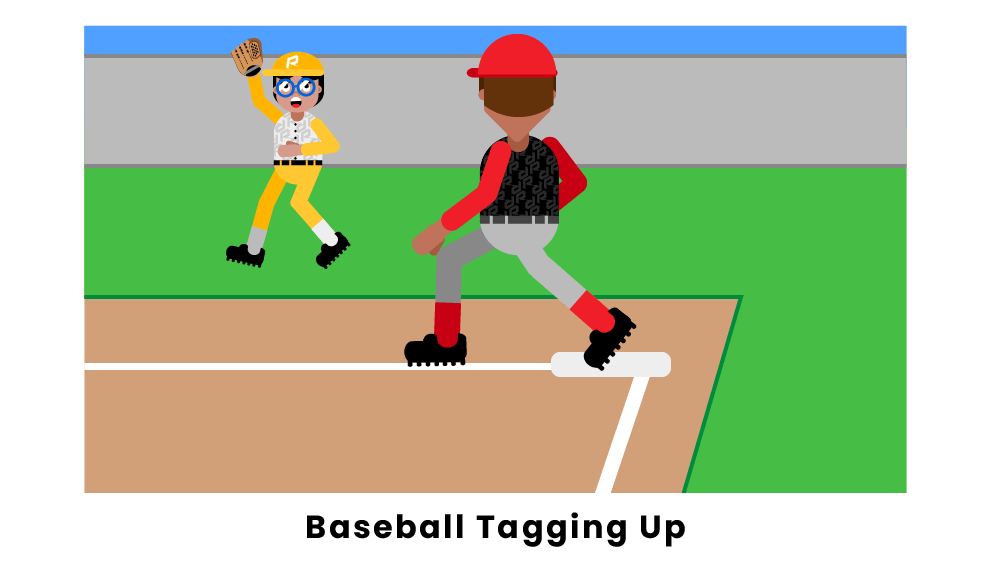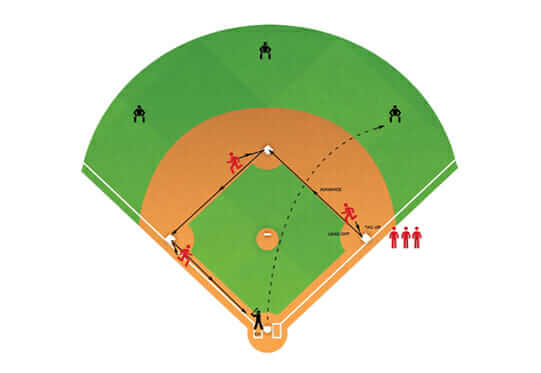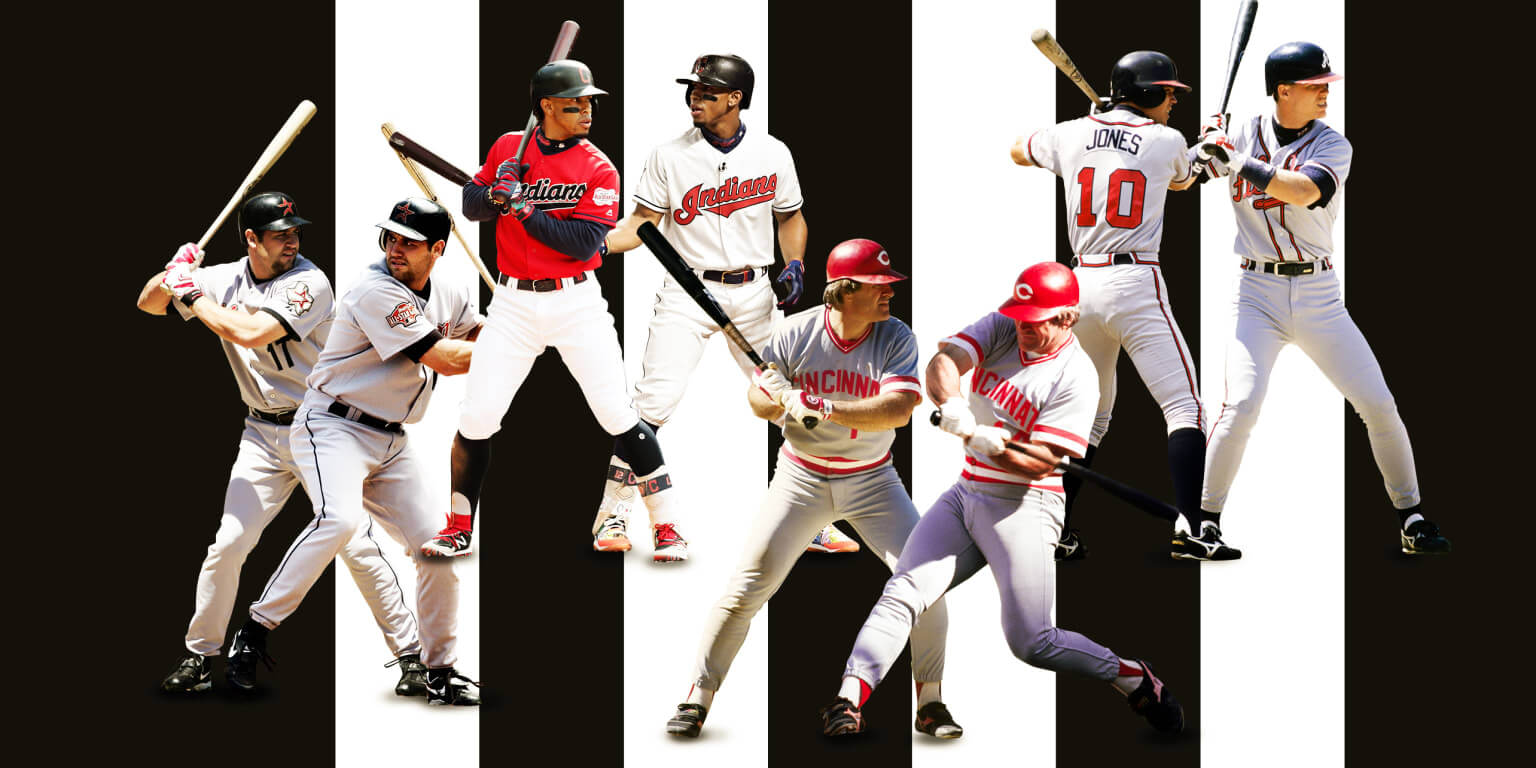Tagging up is an important strategic technique in baseball where a baserunner advances to the next base after a fly ball is caught. The batter hits a fly ball and the fielder catches it for an out. During this time, baserunners have an opportunity to advance to the next base if they retouch or “tag up” on their original base after the catch.
Tagging up allows teams to move runners into scoring position or even score a run on a sacrificial fly ball. It is a way to be aggressive and take extra bases when possible. Proper tagging technique and timing are crucial to gain that extra edge. Teams that master tagging up gain an advantage over the long season.
While risky, tagging up is a strategic play that puts pressure on the defense. This guide will explain when and how to tag up successfully to help your baseball team manufacture more runs.
Definition of Tagging Up

Tagging up is an important strategic play in baseball governed by MLB’s Official Baseball Rules. It refers to a baserunner returning to touch a base after a caught fly ball in order to legally advance to the next base.
According to Official Baseball Rule 5.09(b)(5), a runner is permitted to advance once the ball is first touched by a fielder, provided the runner tags up properly. Specifically, the rule states:
Any runner is out when: After a catch, the runner fails to retouch the base they occupied at the time of the pitch before attempting to advance.
Tagging up requires the runner to retouch or remain on their original base at the time of the pitch until the fielder catches and establishes control of the ball. This allows the runner to legally advance to the next base once the ball is caught, but does not force them to advance. It is a strategic decision by the base coach or runner whether to attempt to tag up or not after a fly ball.
When Tagging Up is Used
Tagging up is most often utilized in specific game situations that allow a baserunner on first or second base to attempt to advance an extra base on a fly ball.
The main scenarios when players will commonly employ the tagging up strategy are:
-
With a runner on first base and less than 2 outs – The runner on first can tag up and try to advance to second base if the batter hits a fly ball. This allows the batting team a chance to get the runner into scoring position. However, there is risk of the runner being thrown out if the catch and throw are executed properly.
-
With a runner on second base and less than 2 outs – The runner on second can tag up and attempt to advance to third base on a fly ball. Getting to third with less than two outs puts pressure on the defense and gives the runner a chance to score on a sacrifice fly. Again, the runner risks being thrown out if they are not careful.
-
With a runner on first or second base and 2 outs – When there are already two outs, the risk vs. reward proposition changes. Since the inning is close to ending anyway, runners are more aggressive about attempting to tag up on any deep fly balls to try to get into scoring position. The potential reward of getting a runner into scoring position is worth the risk of the third out.
-
Scoring from third on a sacrifice fly – Perhaps the most common tagging up scenario is when there is a runner on third base and the batter hits a medium-to-deep fly ball. The runner will tag up and attempt to score on the sacrifice fly, trusting that the catch will be made before they can score. Proper timing and a good throw are needed to prevent the run from scoring.
So in summary, tagging up allows teams a chance to advance runners into scoring position at the risk of getting thrown out. It is used strategically in certain game situations, especially with two outs or a runner on third. The reward often outweighs the risk given the potential impact on the game’s outcome.
Technique and Timing

Executing a proper tag up in baseball requires precise technique and timing to gain the maximum advantage for the batting team. The baserunner must understand both the mechanics of tagging up and the nuances of when to begin their advance to the next base.
Mechanically, the baserunner must remain in contact with their original base until the exact moment the fielder first touches the ball. At that point, the baserunner can then leave the base and attempt to advance. Running before the catch is made and failing to retag results in an automatic out.
The timing of taking off from the original base is critical. The baserunner wants to leave as soon as possible once the catch is made. However, mistiming the departure by reacting late to the catch often eliminates the chance to advance. The runner must anticipate the play, watch for the first touch of the ball, and take off aggressively towards the next base.
Getting a fast first step is especially important on tag ups where the fielder is close to the baserunner. On shallow fly balls, a delayed reaction can lead to the fielder turning and throwing behind the runner who has left the base too late. Proper timing puts pressure on the defense and can lead to extra bases.
Mastering the technique and timing of tagging up is vital to gaining every possible base. It expands baserunning options and puts pressure on the defense. For teams looking to manufacture runs, understanding the nuances of tagging up can create important run-scoring opportunities.
Statistical Analysis
According to baseball analytics, tagging up can be a risky but rewarding base running strategy.
Success rates for tagging up vary depending on the situation:
-
Tagging up from third base has a relatively high success rate of 60-70%, as the runner only has to travel 90 feet to score. Even an average runner can usually make it home safely on a deep fly ball or sacrifice fly.
-
From second base, tagging up is slightly less successful with a 45-55% success rate. Scoring from second requires speed and good baserunning technique. However, aggressive managers may still send runners home from second on a deep fly ball.
-
Tagging up from first base is the most difficult, with only a 25-35% success rate. The distance to cover from first to home is over 270 feet, requiring perfect timing, an above average runner, and a very deep fly ball. Most runners only attempt to advance as far as second or third when tagging up from first.
The deeper the fly ball and the stronger the hitter, the more likely a tag up attempt will be successful. Situational factors like outs, score, and inning can also influence the risk/reward calculation. Overall the success rate decreases for tag ups from third, to second, to first base. But managers and baserunners are still willing to take the chance for the big reward of an extra base or run.
Famous Examples

Tagging up in baseball has led to many memorable and game-changing moments over the years.
Here are some standout examples of successful or impactful tag ups:
-
In Game 7 of the 2016 World Series, the Chicago Cubs’ Kyle Schwarber tagged up from third base on a fly ball to score a critical insurance run. This proved to be the decisive run as the Cubs ended their 108-year championship drought.
-
Derek Jeter tagging up from first base on a fly ball and scoring from second on an errant throw is considered one of the iconic moments from his Hall of Fame career. It embodied his reputation for smart, heads-up baserunning.
-
During his historic 1998 home run chase, Sammy Sosa famously tagged up and scored from second base on a pop fly. This stunned observers and showcased his often overlooked all-around skills.
-
Ichiro Suzuki built a career on exploiting his elite speed, including tagging up aggressively from first base or even home plate. His surprise baserunning helped change the perception of what’s possible on the paths.
-
In a playoff game, Minnesota Twins pinch runner Carlos Gomez scored from second base on a fly out, tagging up on a very shallow ball. It was a bold, unexpected play that fundamentally shifted the game’s momentum.
Tag ups like these have gone down in history by bucking conventional wisdom and dramatically influencing the outcome in crucial games. Their success relies on skill, instincts, and split-second decision making at the highest level.
Common Mistakes
Tagging up may seem straightforward in theory, but even experienced players can make errors.
Here are some of the most frequent mistakes to avoid:
-
Leaving the base too early – Many players are overeager and take off before the catch is made. This usually leads to an easy out. It’s essential to wait until the ball is caught before moving.
-
Missed communication – Tagging up requires coordination between baserunners and coaches. A lack of clear signals can lead to confusion and mistakes. Make sure signs are agreed upon beforehand.
-
Tagging the wrong base – In the excitement of the play, some runners mistakenly return to the starting base instead of the next one. Always be aware of which base you’re supposed to tag.
-
Lack of hustle – Tagging up requires an all-out sprint once the ball is caught. Some players don’t give 100% effort, making it easy for outfielders to throw them out. Hustle is a must.
-
Taking a poor angle – An efficient route is important when tagging up. Taking a bad angle to the next base allows the defense to gain ground. Make sure your path is as direct as possible.
-
Not watching the fielder – Runners need to keep their eyes on the fielder to get the best jump after the catch. Focusing only on the base leads to misjudging the timing.
-
Forgetting to retouch – After tagging up, players must return to touch their original base. In the excitement, this is sometimes forgotten. Be sure to touch the previous base again.
Tagging up is a split-second play that requires precision and focus. Being aware of the common mistakes will help avoid unnecessary outs. With practice, tagging up can become a reliable weapon for advancing runners.
Coaching Tips

Tagging up successfully requires solid fundamentals and repetitive practice. As a coach, focus on teaching the following skills:
-
Reading the fly ball. Outfielders have the best vantage point, so teach players to watch their reaction. Say “Go!” loudly if it looks catchable or “No!” if it will drop.
-
Judging depth. Runners must accurately gauge if the ball was hit deep enough to tag up. Have players practice identifying balls that go past the infield but not warning track depth.
-
Timing the tag. The tag up should happen as the fielder is catching the ball, not before. Stress a quick push off and explosive jump when the ball hits the glove.
-
Sliding technique. A proper slide avoids overrunning the bag while maintaining contact. Demonstrate hook slides and pop-up slides for different scenarios.
-
Situational awareness. Know the field, outs, score, runners on base, and arm strength of the outfielder. Tailor leads and secondary leads accordingly.
-
Reading the catcher. Pick up any cues if the catcher is preparing for a throw behind the runner.
-
Communication. Teach clear, loud communication between runners and base coaches.
With regular repetitions and feedback, players will gain experience tagging up successfully. Keep practicing game-speed situations to ingrain the skills. Proper fundamentals taught at a young age will carry through higher levels of baseball.
Tagging Up vs Other Strategies
Tagging up is related to other baseball baserunning strategies but has some key differences.
-
Tagging up vs leading off: When leading off, a baserunner attempts to steal the next base during the pitcher’s windup and delivery. Tagging up involves advancing after the pitch and when the ball is hit. Leading off is an attempt to steal, while tagging up is in reaction to the batter’s hit.
-
Tagging up vs sliding: Sliding is a technique runners use when approaching a base, whereas tagging up is the act of running toward the next base after a catch. Runners may slide into a base after tagging up as a way to avoid being tagged out.
-
Tagging up vs running on contact: Running on contact involves baserunners advancing as soon as the batter makes contact with the ball. With tagging up, runners wait until after the catch before running. Running on contact is more aggressive and risky than tagging up.
-
Tagging up vs pinch running: Pinch runners are substituted into the game for slow baserunners already on base. Tagging up is a technique for any baserunner attempting to advance after a catch. Pinch running and tagging up are related strategies to help gain extra bases.
The key contrasts are that tagging up is specifically about advancing on a caught ball, while leading off, sliding, running on contact, and pinch running serve other strategic purposes. Knowing when to tag up, and executing it well, is an important baserunning skill.
Conclusion
Tagging up is an important base running strategy in baseball that all players should understand. While it may seem simple on the surface, knowing when and how to properly tag up can make the difference between scoring a key run or ending an inning.
This article summarized the key points about tagging up:
-
Tagging up allows a base runner to advance after a fly ball is caught, but only if they retouch their original base after the catch.
-
Proper technique involves watching for the catch, retouching the base, and then advancing as quickly as possible. Timing is critical.
-
Tagging up is commonly used with less than two outs, and when a deep fly ball is hit. The risk vs. reward must be evaluated.
-
Great base runners through history like Rickey Henderson mastered tagging up to gain extra bases and score runs.
-
Players must be wary of leaving the base too early and being doubled off. Coaches should emphasize proper technique.
-
Compared to stealing bases, tagging up represents a safer way to advance but requires other factors like the depth of a fly ball.
Knowing how and when to tag up is crucial for capitalizing on opportunities to advance bases and score runs. All players should practice technique and study situations where tagging up puts them in better scoring position. Mastering this important base running strategy leads to more runs and wins.








